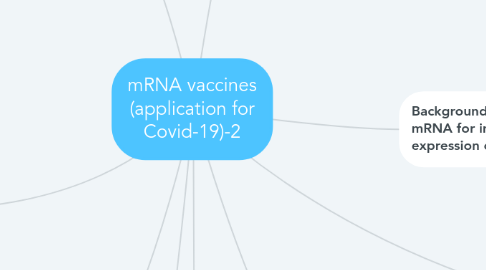
1. Advantages of mRNA vaccines for Covid-19
1.1. Stimulates the body to active the immune system to start creating antibodies against Covid-19
1.2. Uses the genetic sequence of the virus to create a replica of their penetration virulent factor so that the body could create a defense against
1.3. Rapid manufacturing and expeditious modification of the encoded immunogen which accelerate vaccine development
2. Side effects of mRNA vaccines that have been reported so far in clinical trials
2.1. Fatigue.
2.2. Headache.
2.3. Chills.
2.4. Myalgia.
2.5. Pain at injection site.
2.6. Systemic adverse events were common following the second vaccination and in those who received the highest dose.
3. Genetic elements of mRNA vaccines
3.1. mRNA vaccine, mRNA-1273, which encodes the stabilized prefusion SARS-CoV-2 spike protein (S-2P) in healthy adults
3.2. Different innate response mechanisms triggered by mRNA molecules and how each element from the 5' cap to the poly-A tail interferes with innate/adaptive immune responses. Then, we emphasize the importance of some critical steps such as production, purification, and formulation as key events to further improve the quality of immune responses and balance innate and adaptive immunity.
3.3. The introduction of reprogramming factors into differentiated cells in order to induce pluripotency, that mRNAs tagged with the 3' UTR elements discovered in this study outperform those with commonly used 3' UTRs. This approach further leverages the utility of mRNA as a gene therapy drug format.
4. Initial results of using mRNA in human trials
4.1. High Safety, High speed and ease of production, Good potential for cell-mediated immunity
4.2. After the second vaccination, the titers increased with serum-neutralizing activity
4.3. Systemic adverse events of fatigue, , chills, and nausea were mild or moderate in severity after the first vaccination
4.4. mRNA-1273 vaccine was immunogenic, inducing robust binding antibody responses to both full-length S-2P and receptor-binding domain in all participants after the first vaccination in a time- and dose-dependent fashion
4.5. There is no confirmed information of protection from SARS-CoV-2 infection of other respiratory viruses, such as influenza and respiratory syncytial virus
5. Examples of mRNA vaccines used for Covid-19
5.1. BNT162b1
5.1.1. lipid-nanop[article-formulated, nucleoside-modified mRNA vaccine
5.1.2. Encodes the trimerized receptor-binding domain of the spike glycoprotein of SARS-CoV-2
5.1.3. Pain at the injection site was seen 7 days after injection with vaccine (mild-moderate pain)
5.2. mRNA-1273
5.2.1. 2 part vaccination to encode for the spike glycoprotein of SARS-CoV-2
5.2.2. Induced antibody levels that exceeded normal human body production
5.2.3. Induced robust SARS-CoV-2 neutralizing activity and rapid protection in upper and lower airways with no pathologic changes in the lungs
5.3. ChAdOx1 nCoV-19
5.3.1. Single dose of vaccination was found to be effecting in preventing damage to the lungs
5.3.1.1. A second dosing of the vaccination did not show significant increase of immune response
5.3.2. Vaccine that encodes for the codon-optimized full-length spike protein of SARS-CoV-2
5.3.3. Was seen to not prevent infection or transmission of SARS-CoV-2 but significantly reduce illness from it
6. Expected timeline for developing an approved mRNA vaccine
6.1. Prove the vaccine is effective: Expected timeline for developing an approved mRNA vaccine.
6.2. Prove the vaccine is safe: safety data from thousands of patients being treated with the vaccine.
6.3. Prove the vaccine can be consistently manufactured: a good amount of the vaccine will be needed to provide to the population.
7. Background about Synthetic mRNA for inducing the expression of proteins
7.1. mRNA vaccines have the potential to streamline vaccine discovery and development, and facilitate a rapid response to emerging infectious diseases
7.1.1. mRNA vaccines elicit a potent immune response including antibodies and cytotoxic T cells.
